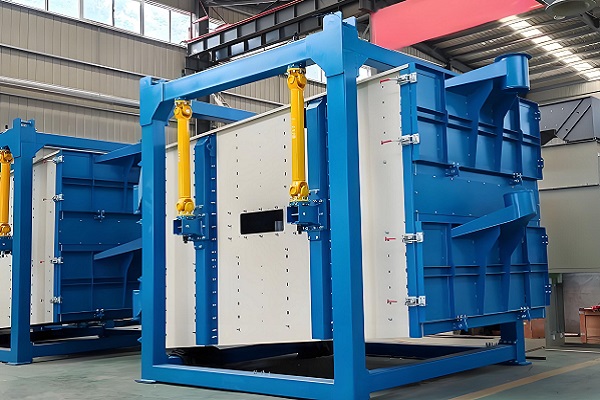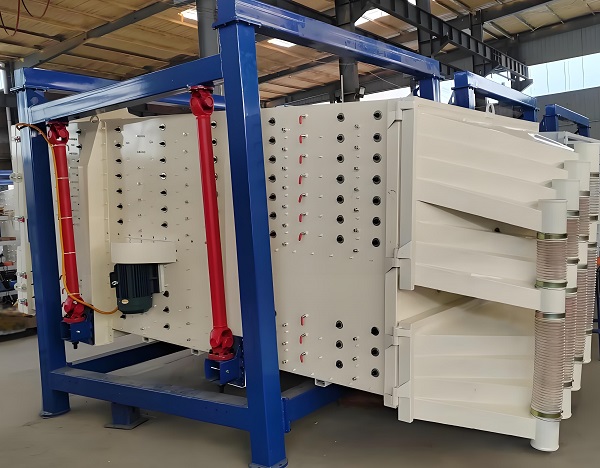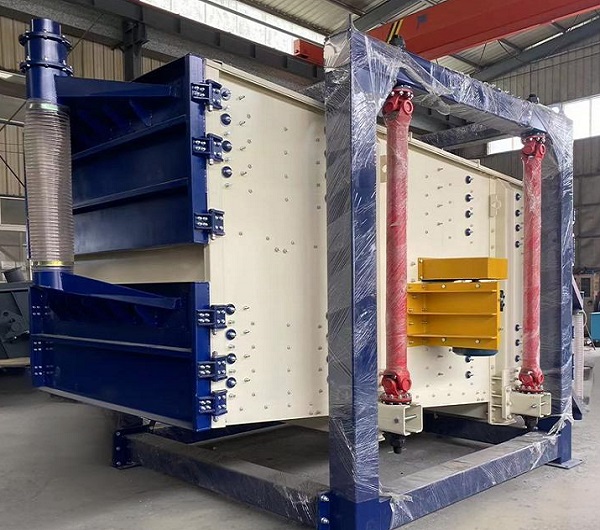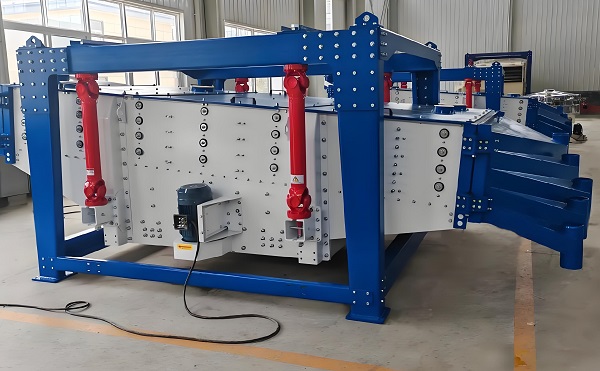In the material grading process of industrial production, the efficiency, accuracy, and stability of screening equipment directly affect product quality and production efficiency. Traditional screening equipment generally suffers from problems such as material clogging of the screen, insufficient grading accuracy, and high operating noise, making it difficult to adapt to the screening needs of materials prone to agglomeration and with multiple particle size distributions. The swing screen, with its unique motion mode mimicking manual swaying and optimized structural design, has become the core equipment for solving these problems. This article focuses on the core structural features of the gyratory screen, deeply analyzing its design logic and advantages from four dimensions: core working components, support and transmission system, screening chamber design, and auxiliary functional structures. It provides professional reference for industry selection and maintenance, helping production lines achieve efficient and accurate screening.

A. Core Working Components: The Core Guarantee of Screening Efficiency
The screening performance of the swing screen mainly relies on its optimized core working components, whose structural characteristics directly determine the material separation effect and throughput.
1. Precision Design of Screen Box and Screen Mesh The screen box, as the core cavity for material screening, is welded from high-strength steel plates and CNC machined to ensure dimensional accuracy. The interior of the box is reinforced with stiffeners, providing strong resistance to deformation and withstanding long-term high-frequency oscillation impacts. Screen boxes are typically designed with a multi-layer structure, with the number of layers flexibly configured according to screening needs (1-5 layers). Each layer is equipped with an independent screen and discharge port, enabling simultaneous separation of multiple levels of materials. The screen mesh is fixed using a "tensioned pressure frame + wedge block locking" structure. Compared to traditional bolt fixing, this design is not only easier to install but also ensures a flat, wrinkle-free screen, effectively preventing material accumulation. Simultaneously, wear-resistant rubber strips are added to the screen edges to reduce impact wear and extend service life. Screen mesh materials can be selected according to material characteristics, such as stainless steel woven mesh, perforated mesh, and polyurethane mesh, with apertures ranging from 0.074mm to 50mm to suit the screening needs of materials of different particle sizes.
2. Dynamics Optimization of the Swinging Mechanism
The swinging mechanism is the core component driving the screen box movement. It adopts an "eccentric shaft + connecting rod" transmission structure. The eccentric shaft is made of high-quality 45# carbon steel, and its surface is heat-treated to improve hardness and wear resistance. The eccentricity can be adjusted within the range of 5-20mm, allowing for precise control of screening speed and amplitude. The connection between the connecting rod and the screen box/eccentric shaft uses a universal joint, which effectively compensates for angular deviations during movement, reduces mechanical wear, and ensures smooth and efficient power transmission. Compared to the high-frequency vibration of a vibrating screen, the swinging mechanism of the swinging screen uses a low-frequency (180-300r/min), large-amplitude (5-20mm) motion mode, forming a simulated manual swinging trajectory along the screen surface. This ensures sufficient material diffusion and avoids the uneven material stratification problem caused by high-frequency vibration, making it particularly suitable for screening easily agglomerated and sticky materials.
B. Support and Transmission System: Key to Operational Stability
The structural design of the support and transmission system directly affects the operational stability, energy consumption, and service life of the gyratory screen, forming the foundation for long-term reliable operation.

1. Vibration Reduction and Noise Reduction Design of the Support Structure
The gyratory screen adopts a vibration-damping structure of "spring support + base." The base is welded from heavy-duty steel plates and equipped with leveling feet at the bottom, allowing for precise adjustment of the equipment's level according to the site conditions, ensuring even force distribution during operation. The support springs are high-elasticity rubber springs or cylindrical helical springs, installed between the screen box and the base, in 4-6 symmetrically distributed springs. This effectively absorbs the vibration energy generated by the screen box's swaying, reducing the impact on the ground and lowering operating noise (noise level ≤75dB), improving the working environment. Some high-end models also add buffer pads between the springs and the base to further enhance the vibration reduction effect and prevent long-term vibration from affecting the plant structure.
2. High-Efficiency and Energy-Saving Design of the Transmission System
The transmission system consists of a motor, reducer, coupling, and other components. The motor uses a YE2 series high-efficiency three-phase asynchronous motor, reducing energy consumption by 10%-15% compared to traditional motors. It also features overload protection to effectively prevent equipment damage due to material overload. The reducer uses a hardened gear reducer with a transmission efficiency of over 95%, providing stable output torque. Precise connection to the eccentric shaft via a coupling ensures error-free power transmission. Some equipment is also equipped with a variable frequency speed control device, which can adjust the motor speed in real time according to material characteristics and screening requirements, achieving stepless adjustment of the oscillation frequency to adapt to different working conditions and improve the flexibility and applicability of the equipment.
C. Humanized Design of the Screening Chamber: Dual Enhancement of Convenience and Adaptability
The screening chamber of the swing screen is designed with ease of operation and adaptability to various working conditions in mind. Through a series of humanized structural designs, the practicality and maintainability of the equipment are improved.

1. Sealing and Dustproof Structure
Addressing the dust pollution problem in industrial production, the gyratory screen adopts a fully enclosed cavity design. Wear-resistant rubber gaskets are installed between the screen box and the base, and between the feed inlet and the discharge outlet, ensuring reliable sealing performance, effectively preventing dust leakage, and protecting the working environment and operator health. The feed inlet is designed with a funnel-shaped structure to reduce material impact and prevent material splashing during feeding; the discharge outlet uses an adjustable baffle design for easy control of discharge speed and direction, adapting to different receiving equipment. Some models are also equipped with a pulse dust collector interface, which can be directly connected to a dust collection system to further enhance dust prevention and meet environmental protection requirements.
2. Inspection and Maintenance Structure
To facilitate equipment inspection and screen replacement, the gyratory screen incorporates several convenient designs: a quick-opening inspection door is located on the side of the screen box, connected by a snap-fit mechanism, allowing operators to quickly open it without tools for easy cleaning of residual materials and inspection of the screen; the screen adopts a modular design, with each layer of screen independently removable and replaceable, simplifying the replacement process and significantly reducing maintenance time without disassembling the entire screen box; the transmission components and electrical system are equipped with independent protective covers, providing both safety protection and easy access for inspection and maintenance.
D. Auxiliary Functional Structure: Comprehensive Enhancement of Functionality and Safety
In addition to the core structure, the swing screen is equipped with a series of auxiliary functional structures to further enhance the equipment's functionality, safety, and service life.

1. Anti-clogging Design of the Screen Cleaning Device
To solve the problem of material clogging the screen, the swing screen is equipped with various screen cleaning devices, commonly including bouncing ball screen cleaning, ultrasonic screen cleaning, and brush screen cleaning. The bouncing ball cleaning device automatically cleans the screen openings by placing elastic bouncing balls under the screen and using the swaying of the screen box to cause the balls to impact the bottom of the screen. It is suitable for most dry materials. The ultrasonic cleaning device uses an ultrasonic generator to produce high-frequency vibrations, which are transmitted to the screen surface to effectively remove blockages caused by fine materials, making it suitable for fine screening applications. The brush cleaning device uses rotating brushes to continuously clean residual materials inside the screen openings, suitable for highly viscous materials.
2. Safety Protection Structure The swing screen is designed to meet industrial safety standards and is equipped with comprehensive safety protection devices: protective covers are installed on the transmission components to prevent accidental contact with moving parts by operators; in case of abnormal vibration or overload during operation, the overload protection device will cut off the power supply in time to avoid equipment damage; a limit device is installed between the screen box and the base to prevent structural damage caused by excessive swaying angles; the electrical control system is equipped with leakage protection to ensure electrical safety. In addition, the equipment surface is treated with electrostatic powder coating, making it rust-proof and corrosion-resistant, and suitable for harsh industrial environments such as humid and dusty conditions.
E. Synergistic Advantages of Structural Design: A Comprehensive Embodiment of High-Efficiency Screening
The various structural components of the gyratory screen do not work independently, but rather achieve a synergistic effect through scientific design, collectively realizing efficient, stable, and convenient screening. The optimized gyratory mechanism combined with the multi-layer screen box structure ensures thorough material screening while increasing throughput per unit time; the vibration-damping support structure and efficient transmission system work together to reduce energy consumption and noise, extending service life; the synergistic effect of the sealed dustproof structure and screen cleaning device protects the environment and prevents screen clogging, ensuring stable screening efficiency; and the convenient maintenance structure reduces equipment operating costs and improves the overall cost-effectiveness.

The structural design of the swing screen fully embodies the core concepts of "high efficiency, stability, convenience, and safety." Through the precise design of core working components, the optimized and upgraded support and transmission system, the user-friendly innovation of the screening chamber, and the comprehensive enhancement of auxiliary functional structures, it has been widely applied in various industries such as coal, ore, grain, chemicals, and building materials. Compared to traditional screening equipment, the gyratory screen not only boasts advantages such as high screening efficiency, wide material adaptability, and stable and reliable operation, but also excels in ease of operation, maintenance costs, and environmental performance, making it an indispensable key piece of equipment in modern industrial production. With continuous technological advancements, the gyratory screen's structural design will continue to be optimized, such as by incorporating intelligent monitoring systems and enhancing automation, providing stronger support for high-quality development across various industries.
Save Time! Get A Detailed Quotation Quickly.
